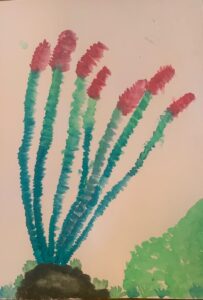lOCO for OCOtillo
Stephen Stresow-Cortez
Stephen Stresow-Cortez (he/him) was born and grew up in El Paso, Texas, which he credits for sparking his interest in plants, agriculture, and food systems. He explored this passion with local organizations, such as the Master Gardeners and Naturalists and Native Plant Society. In high school, he volunteered with LaSemilla, which was the first farm he ever visited and helped dispel the idea that deserts are food-less places. He is grateful for LaSemilla’s expansive food systems work, such as their Farm Bill zine and Cultural Fellowship. Stephen is currently a Ph.D. student researching nutrient cycling in organic vegetable systems with the hope of making farming more sustainable and helping put more veggies on the table. He enjoys hiking, birdwatching, running, trying new recipes, and rewatching Star Wars media when not in the lab.
~~~
Foquieria splendens is a plant that has earned their name. Whether it is flowering, leafed out, or a bare, thorny tower, ocotillo is a truly splendid sight. It has unequivocally become my favorite desert shrub, in no small part because it was one of the first plants I could confidently identify. I was born and grew up in El Paso, TX, but–thanks to TV networks like Animal Planet–I did not become interested in plants until I started gardening in middle school. As I write this, I am finishing up my first year as a PhD student in plant science (horticulture). Throughout this journey, ocotillo and the lessons it can teach kept coming up. The plant reminds me of home even though, ironically, we never had one in our yard. Now, gorgeous paintings of ocotillos greet me whenever I deboard a plane at the El Paso Airport (until we get a more accessible train system), which is the first sign that I am home.
Outdoors, ocotillo stands tall as it greets onlookers; at the airport, it is painted onto trash cans. Regardless of their beauty, “trash” is how deserts have often been described to me. At first glance, ocotillo seems to fit this bill and looks like nothing more than a dead mess of debris. Just because the Chihuahuan Desert is not as grandiose as a forest, however, does not mean that standing in it cannot be just as awe-inspiring. It is my personal mission to help others appreciate the intricacies found in the Chihuahuan Desert–the most biologically diverse desert in the Western hemisphere. For many desert plants like ocotillo, much of the beauty lies in the details of their survival strategies. Other adaptations like thick, waxy leaves (think succulents), storing water in the stem, or using CAM photosynthesis at night that desert plants use are much more obvious than the ephemeral life strategy of ocotillo. When it rains, ocotillo quickly leafs out for a few days before dropping all of its leaves again. How does it photosynthesize and provide energy for itself for the rest of the year? Through its stem, much like my favorite desert tree palo verde (Parkinsonia aculeata). Not a single thing about this plant is “ordinary” and getting to witness so many survival strategies up close is remarkable. Well, not TOO close.
Like the people here, these plants are tough. As I marvel at its adaptability, I am also in awe of the ingenuity people have had to call this place home for the past 10,000 years. When I see ocotillo as I drive through Transmountain to get to the El Paso Museum of Archeology or see it as I hike to the pictographs and petroglyphs in Hueco Tanks, I think about all the people before me who stood in the same spot and saw the same plants. On the rare occasion that our “non-soons” have filled up the huecos at Hueco Tanks and ocotillo is also in-leaf, I am reminded of the abundance of the Chihuahuan Desert. I have never tried them, but the flowers and leaves of ocotillo are edible and are supposed to have a zesty taste. There are few trees in this region and given the choice between a fence or lumber for a house, I would choose the latter. I remember the Franklin Park Ranger explaining to my middle school class on a field trip how ranchers used to (and I am sure many still do) plant segments of ocotillo and use them at living fences. Like the plant itself, there is so much beauty in the simplicity of this technique. It is a reminder that “biodesign” or sustainable design is something we have been doing for a long time and that the Indigenous people living and working on the land possess vast knowledge about how to use these plants. A newfound hobby of mine has been looking for fossils. If you also enjoy this, I highly recommend the Dino Tracks Trail near Mt. Cristo Rey or looking at any rock wall around town. The desert is like a beach without water. Millions of years ago, however, the entire region was submerged under an ancient ocean. As I find the fossilized remnants of fish or shells, I can’t help but laugh at how fitting the name “desert coral” is for ocotillo.
People are not the only ones who benefit from ocotillo being nearby. The totally tubular flowers on the plant gave ocotillo the names “flaming sword” and “candlewood.” They also helped get me into birdwatching and opened my eyes to the impact humans can have on species thousands of miles away. The bright red flowers are perfectly designed to attract hummingbirds, although many of the native bees in the region also pollinate the plant. (Pro Tip: hummingbirds are attracted to red, so if you have a hummingbird feeder, painting the yellow spouts red will help attract more hummingbirds and keep the wasps away). The flowers are only a small part of how ocotillo benefits these marvelous birds. Hummingbirds are territorial, so they appreciate being able to use ocotillo as an outlook so they can keep an eye on any intruders trying to access their flowers. El Paso is extremely lucky because we are on a hummingbird migration path and residents get to see more species of hummingbird than most of the continental United States. Black-chinned, Rufous, Calliope, Broad-tailed, and Ana’s hummingbirds have all been found here. For context, the Midwest and Northeast only have 1 species. Once they find a spot they like, hummingbirds will return to the same spot each year on their migratory route to fuel up. Unfortunately for them, many of their pit stops have been paved over for development. This has led to starved hummingbirds that were unable to fuel up falling out of the sky–dead–during their sometimes thousand-plus mile migrations. I argue that we have a responsibility to our non-human counterparts who rely on the Desert, especially if we know they are coming back to the same spot. When we do develop native habitat, it is a great opportunity to plant native plants like ocotillo. It is best to buy nursery/seed-grown ocotillo rather than wild-harvested ones so that we are not taking any more lookout posts from our bird buddies. For more ways to help hummingbirds, I highly recommend Marcy Scott’s book Hummingbird Plants of the Southwest.
When I first moved to upstate New York and then mid-Michigan for school, I could not identify any plants beyond “tree” and “this is more green than I have seen in my entire life.” One of the beautiful things about ecology is that many of the same phenomena are present across ecosystems and, fortunately, the Desert is a great teacher for this. This morning, for example, I went on a run through the 0.25 square miles of old-growth forest on campus. Ocotillo drops its leaves to conserve water, just like the hundred-foot-tall trees here do in winter. The ephemeral life strategy is the same one that the wildflowers (and delicious ramps) popping up on the forest floor use. I look at the flowers and debate making floral drinks the same way I do with plants like American sumac.
On a professional level, I feel so lucky that I got my introduction to plants in El Paso. It was the perfect place to explore some of the best that the botanical world has to offer. The desert is beautiful and I savor the months I am back home, soaking up as much sun as I can. I have carried the lessons I learned with me about resilience, adaptability, and seeing beauty in unexpected places.
This guest blog and included imagery are a part of a series, led by our Storytelling program, that is documenting and uplifting an assortment of Chihuahuan Desert plants through the lived experiences, deep connections, and expertise of our broader community. This work is supported by the Pisces Foundation. Keep an eye out for more Chihuahuan Desert plant stories and content!



